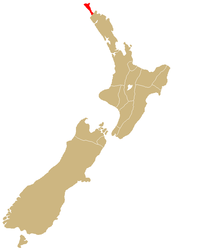Ngāi Takoto
| Ngāi Takoto | |
|---|---|
| Iwi (tribe) in Māoridom | |
 | |
| Rohe (region) | Northland |
| Waka (canoe) | Kurahaupo |
| Population | 1,113 |
| Website | http://www.ngaitakotoiwi.co.nz/ |
Ngāi Takoto is a Māori iwi from Northland, New Zealand. The iwi is one of the six Muriwhenua iwi of the far north of the North Island. Ngāi Takoto trace their whakapapa (ancestry) back to Tuwhakatere,[1] and trace their arrival in New Zealand to the Kurahaupo waka (canoe).[2] The rohe (tribal area) of the iwi is focused on the upper North Island and extends to Kermadec Islands, Three Kings Island, Cape Reinga, Pao Island, Ninety Mile Beach, Waimimiha River, Ohaku hills, Whangatane River, Rangaunu Harbour and North Cape.[3]
In the 2013 New Zealand census, 1,113 people affiliated with Ngāi Takoto, less than 1 percent of the total Māori population. 18.3 percent identified solely with the iwi and 81.5 percent also affiliated with other iwi. 33.2 percent of people could hold a conversation about everyday things in te reo Māori (the Māori language). The median age was 28.5 years, compared to the national median of 38.0. The median adult income was $23,800, compared to the national median of $28,500.[4] The unemployment rate was 12.8%, compared to 7.1% nationwide.[5]
The iwi signed a Treaty of Waitangi settlement with the Crown in 2012, after being with almost no land following colonisation. The settlement included commercial redress of $21.04 million, and the return of Wharemaru East Beach and other culturally important sites. The iwi agreed to co-govern Ninety Mile Beach with Northland Regional Council, Far North District Council and other Te Hiku iwi, and to be involve in conservation decisions about public lands through the Korowai for Enhanced Conservation organisation. Under the settlement, the Crown and the iwi agreed to work together on a social development strategy.[6]
Hapu and marae
There are no hapū (sub-tribes) with the iwi (tribe). The following marae (meeting places) and wharenui (meeting houses) are affiliated with the iwi as a whole:
- Kaimaumau, No wharenui, Waiharara
- Mahimaru, Te Whakamomoringa, Awanui
- Te Pā a Parore, Te Pā A Parore, Awanui
- Waimanoni, Wikitoria, Awanui[7]
Organisations
The iwi is represented by two charitable trusts. Te Runanga o Ngāi Takoto is the post-Treaty settlement governance entity. It represents Ngāi Takoto as an "iwi authority" under the Resource Management Act, has five representatives chosen from the Ngāi Takoto marae committee, and is based in Kaitāia.[8] Ngā Taonga o Ngaitakoto Trust is the mandated iwi fisheries organisation. It was set up under the Māori Fisheries Act to manage the iwi's customary fisheries rights, has 11 trustees from iwi whānui, and is based in Awanui.[9]
Te Reo Irirangi o Te Hiku o Te Ika, an iwi radio station, serves Ngāi Takoto and other Muriwhenua tribes of the Far North. It broadcasts a main station on 97.1 FM, an urban contemporary station Sunshine FM on 104.3 FM and a youth-oriented station Tai FM.[10]
Demography
In 2013, 51.3% of iwi members lived in urban ares, compared to 65.6% of the total Māori population. 94.3% of iwi members lived in the North Island and 5.9% or 66 people lived in the South Island. Most members lived in the Northland Region (44.5%), the Auckland Region (33.2%) and Waikato Region (5.4%).[11] 30.5% were under the age of 15 years, compared with 33.1% of the total population of Māori descent. 22.1% were aged 15–29 years, 41.0% were aged 30 to 64 years, and 6.7& were aged 65 and over. 45.0% of the population was male and 55.3% was female.[12]
See also
External links
References
- ^ "Ngāi Takoto". ngaitakotoiwi.co.nz. Ngāi Takoto. Retrieved 2 March 2016.
- ^ "Report Chapter 18". waitangi-tribunal.govt.nz. Waitangi Tribunal. Retrieved 2 March 2010.
- ^ "Rohe". tkm.govt.nz. Te Puni Kōkiri, New Zealand Government. Retrieved 2 March 2016.
- ^ "Key facts". stats.govt.nz. Statistics New Zealand. Retrieved 2 March 2016.
- ^ "Labour force". stats.govt.nz. Statistics New Zealand. Retrieved 2 March 2016.
- ^ "Crown signs $20m deal with Ngai Takato". APN News & Media. NZ Herald. 28 October 2012. Retrieved 2 March 2016.
- ^ "Hapū and marae". tkm.govt.nz. Te Puni Kōkiri, New Zealand Government. Retrieved 2 March 2016.
- ^ "Official website". ngaitakotoiwi.co.nz. Ngai Takoto. Retrieved 2 March 2016.
- ^ "Iwi Representative Organisations". tkm.govt.nz. Te Puni Kōkiri, New Zealand Government. Retrieved 2 March 2016.
- ^ "Kaitaia". Welcome to the Radio Vault. New Zealand: The Radio Vault. 23 July 2009. Archived from the original on 27 August 2009. Retrieved 12 June 2015.
{{cite web}}:|archive-date=/|archive-url=timestamp mismatch; 9 October 2009 suggested (help) - ^ "Population and geography". stats.govt.nz. Statistics New Zealand. Retrieved 2 March 2016.
- ^ "Age and sex". stats.govt.nz. Statistics New Zealand. Retrieved 2 March 2016.
